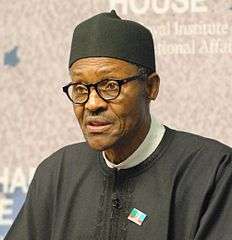Buharism
| Part of a series on |
| Nationalism |
|---|
|
Core values |
|
Organizations |
| Politics portal |
Buharism is a term rooted in the politics of Nigeria, referring to the economic principles and the political ideology of the military government of Nigeria headed by General Muhammadu Buhari from 31 December 1983 to 27 August 1985. This ideology shares common features with fascism; the government was a right-wing nationalist government that pursued corporatist economic programs and curtailed personal freedoms.[1] Economic reforms were characterised as moving the political economy away from the control of a "parasitic" elite, and into the control of an emerging "productive" class. Buharism represented a two-way struggle: with external global capitalism and with its internal agents and advocates.[2]
Economic theory
Buharism rejected the dominant approach of the Washington Consensus, rather holding that for a crisis-wrecked country to successfully improve its balance of payments through devaluation, there must first exist a condition that the price of every country's export is denominated in its own currency. As such a condition did not exist, Buharism asserted that, for any country that Washington Consensus conditions do not exist clearly enough, there are alternate and superior approaches to solving the problem of its economic crisis.[2] Therefore, instead of applying devaluation to get the then crisis-wrecked economy of Nigeria back on track, Buharism rather employed a policy of curbing imports of goods deemed unnecessary, curtailing oil theft and improving exports through a counter trade policy of bartering seized illegally bunkered crude oil for needful goods like machinery, enabling it to export above its OPEC quota.[3]
References
- ↑ This government also introduced War Against Indiscipline(WAI) Sanusi Lamido Sanusi (20 February 2003). "Buharism as Fascism: Engaging Balarabe Musa". London. Retrieved 12 September 2013.
- 1 2 Sanusi Lamido Sanusi (22 July 2002). "Buharism: Economic Theory and Political Economy". Lagos. Retrieved 12 September 2013.
- ↑ "Military Regime of Buhari and Idiagbon". Retrieved 12 September 2013.
External links
- Buharism Beyond Buhari: A Response to Mohammed Haruna by Sanusi Lamido Sanusi on 6 September 2002 in London
- Buhari and Idiagbon: A Missed Opportunity for Nigeria by Max Siollun in October 2003
- The Spontaneous 'Buharism' Explosion in the Polity by Mohammed Nura on 14 September 2010 inLeadership (Nigeria)
